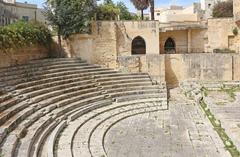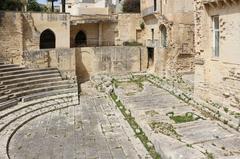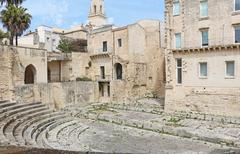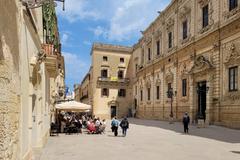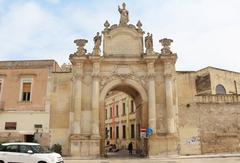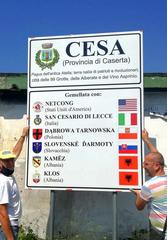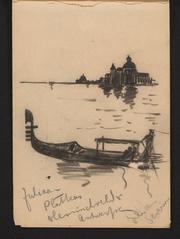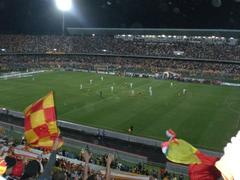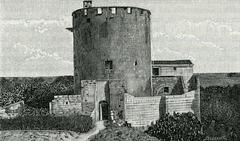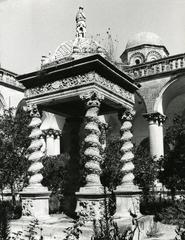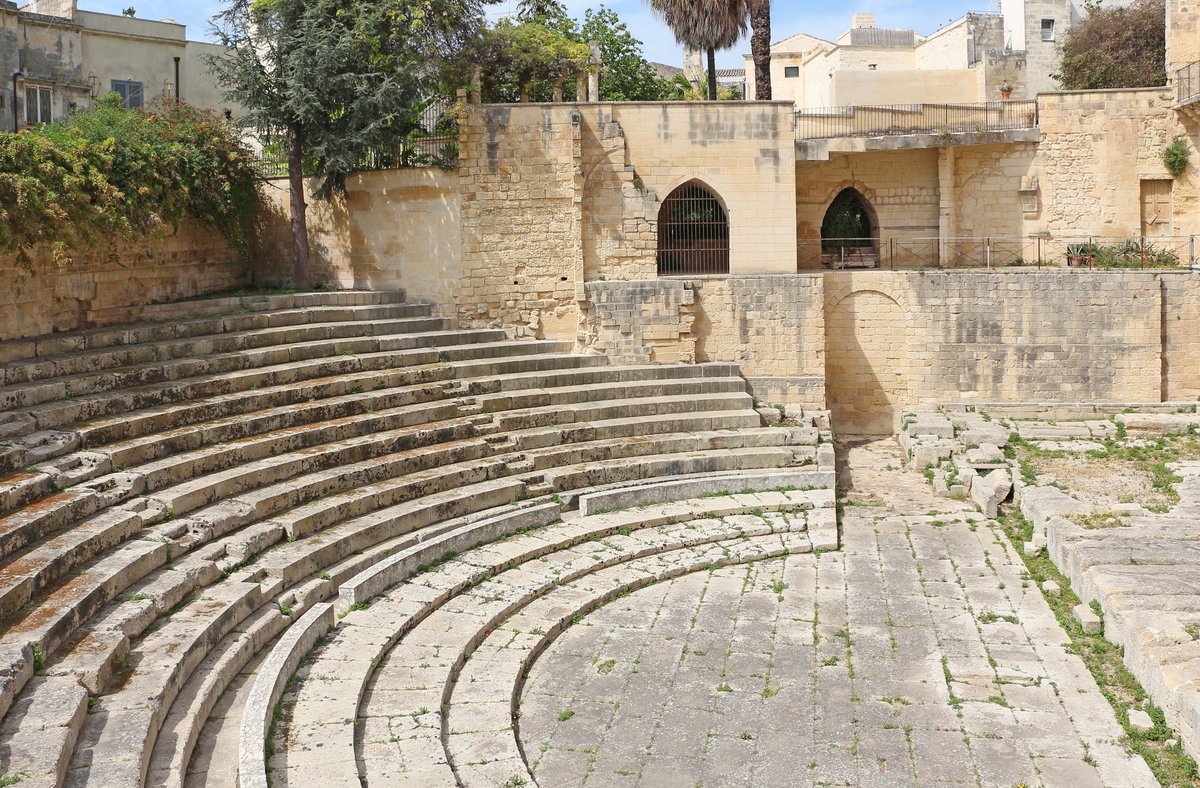
Teatro Romano di Lecce Visiting Guide: Hours, Tickets, Tips and More
Date: 24/07/2024
Introduction
Nestled in the heart of Lecce, Italy, the Teatro Romano di Lecce is a hidden gem that offers a captivating glimpse into the ancient Roman civilization. Discovered serendipitously in 1929 during excavation work in the gardens of Palazzo D’Arpe and Palazzo Romano, this theatre is a testament to the rich historical tapestry of Lecce (Nomads Travel Guide). With origins tracing back to the Augustan period, it is believed that Octavian, who later became Emperor Augustus, commissioned its construction as a gesture of gratitude to the city of Lupiae (ancient Lecce) for its hospitality (Wikipedia). From its impressive architectural features to its role as a cultural hub, the Teatro Romano di Lecce continues to be a significant landmark that attracts historians, archaeologists, and tourists alike.
The theatre’s architectural design is a marvel of Roman engineering, with its cavea (seating area) divided into six wedges, each containing twelve steps, and an orchestra area designated for the choir. Decorative elements and statues, some dating back to the Antonine period, enhance the site’s historical richness and are now preserved in the Museo del Teatro Romano (Nomads Travel Guide). Despite being overshadowed by the larger Roman Amphitheatre, the Teatro Romano di Lecce’s intimate setting highlights its cultural significance in hosting comedies and tragedies, reflecting the diverse cultural offerings of ancient Lecce (Atlas Obscura).
Today, the Teatro Romano di Lecce remains a vital cultural landmark, seamlessly integrated into the city’s historic center. Visitors can explore the theatre through guided tours and enjoy performances that animate this ancient structure, ensuring its enduring legacy and importance to Lecce’s cultural fabric (Maddy’s Avenue). This comprehensive guide will delve into the theatre’s history, architectural significance, visitor information, and more, offering valuable insights for anyone planning to explore this remarkable site.
Table of Contents
- Exploring the Teatro Romano di Lecce - History, Visiting Hours, and Cultural Significance
- Discovery and Initial Excavations
- Augustan Era Origins
- Architectural Features
- Decorative Elements and Statues
- Capacity and Performances
- Modern-Day Significance
- Preservation and Accessibility
- Visitor Information
- Comparative Analysis with the Roman Amphitheatre
- Integration into Lecce’s Urban Fabric
- Educational and Cultural Impact
- FAQ Section
- Essential Visitor Tips for Exploring Teatro Romano di Lecce - Tickets, Hours, and More
- Introduction
- Location and Accessibility
- Opening Hours and Admission
- Best Time to Visit
- Guided Tours
- History and Cultural Significance
- Nearby Attractions
- Photography Tips
- Practical Tips
- Dining and Refreshments
- Safety and Etiquette
- Accessibility for Disabled Visitors
- Souvenirs and Shopping
- Transportation
- FAQ
Exploring the Teatro Romano di Lecce - History, Visiting Hours, and Cultural Significance
Discovery and Initial Excavations
The Teatro Romano di Lecce was serendipitously discovered in 1929 during excavation work in the gardens of two historic palaces, Palazzo D’Arpe and Palazzo Romano (Nomads Travel Guide). This discovery unveiled a crucial piece of Lecce’s ancient history, previously hidden beneath the surface for centuries.
Augustan Era Origins
The origins of the Teatro Romano di Lecce are closely tied to the early Roman Empire, specifically the Augustan period. It is believed that Octavian, who later became Emperor Augustus, found refuge in Lupiae (the ancient name for Lecce) before his rise to power. In gratitude for the city’s hospitality, he ordered the construction of both the Roman Theatre and the more famous Roman Amphitheatre (Wikipedia).
Architectural Features
The theatre’s architectural design is a testament to Roman engineering prowess. The seating area, known as the cavea, is divided into six wedges, each containing twelve steps. This design allowed for efficient crowd management and optimal viewing angles for the audience. The orchestra area, designated for the choir, is accessible via a narrow gallery. In front of the orchestra are three steps of white limestone, reserved for prominent spectators. Behind these steps lies a low wall, with the stage situated behind the orchestra (Nomads Travel Guide).
Decorative Elements and Statues
Decorative fragments found at the site suggest that parts of the theatre date back to the Augustan period. Additionally, marble statues discovered at the site are thought to belong to the era of the Antonines, between 138 and 182 AD. These statues and decorative elements are now housed in the adjacent Museo del Teatro Romano, preserving the artistic heritage of the site (Wikipedia).
Capacity and Performances
Although not as large as the Roman Amphitheatre, the Teatro Romano di Lecce could accommodate around 5,000 spectators. It primarily hosted comedies and tragedies, eschewing the grandiose spectacles typical of the amphitheatre. This focus on theatrical performances highlights the cultural significance of the theatre in ancient Roman society (Nomads Travel Guide).
Modern-Day Significance
Today, the Teatro Romano di Lecce remains a vital cultural landmark. It is possible to visit the theatre externally and enter the interior during frequent performances and events that continue to animate the ancient structure. This ongoing use of the theatre for cultural events underscores its enduring legacy and importance to the city of Lecce (Wikipedia).
Preservation and Accessibility
The preservation of the Teatro Romano di Lecce has been a priority for local authorities. The site is maintained to ensure its structural integrity and historical authenticity. Visitors can explore the theatre through guided tours, which provide in-depth insights into its history and architectural features. The adjacent Museo del Teatro Romano offers additional context and displays artifacts recovered from the site, enhancing the visitor experience (Maddy’s Avenue).
Visitor Information
Visiting Hours: The Teatro Romano di Lecce is open to visitors from 9 AM to 7 PM daily. It is recommended to check for any special closures or events that might affect visiting hours (Visit Lecce).
Ticket Prices: Admission fees are reasonable, with discounts available for students, seniors, and groups. A combined ticket with the Museo del Teatro Romano offers additional savings.
Accessibility: The site is partially accessible to those with mobility issues. Certain areas may require assistance or may be challenging to navigate.
Guided Tours: Guided tours are available in multiple languages and can be booked in advance through local tour operators or directly at the site.
Comparative Analysis with the Roman Amphitheatre
While the Teatro Romano di Lecce is a significant historical site, it is often overshadowed by the larger Roman Amphitheatre located in Piazza Sant’Oronzo. The amphitheatre, discovered in 1901, could hold between 12,000 and 14,000 spectators and was used for gladiatorial contests and other grand spectacles (Atlas Obscura). In contrast, the Teatro Romano’s more intimate setting was suited for theatrical performances, highlighting the diverse cultural offerings of ancient Lecce.
Integration into Lecce’s Urban Fabric
The Teatro Romano di Lecce is seamlessly integrated into the city’s historic center. Its location near Piazzetta Vittorio Emanuele II and Piazzetta Giuseppe Pellegrino makes it a surprising and delightful discovery for visitors exploring the medieval streets of Lecce. This integration reflects the city’s rich historical layers, where ancient Roman structures coexist with Baroque architecture and modern developments (Visit Lecce).
Educational and Cultural Impact
The Teatro Romano di Lecce serves as an educational resource, offering insights into Roman architecture, urban planning, and cultural practices. Schools and universities frequently organize educational tours to the site, fostering a deeper understanding of ancient history among students. Additionally, the theatre’s continued use for performances and events ensures that it remains a vibrant part of Lecce’s cultural life (Savoring Italy).
FAQ Section
Q: What are the visiting hours for the Teatro Romano di Lecce?
A: The theatre is open daily from 9 AM to 7 PM. Check for any special closures or events.
Q: How much are the tickets?
A: Admission fees are reasonable, with discounts for students, seniors, and groups. Combined tickets with the Museo del Teatro Romano offer additional savings.
Q: Is the Teatro Romano di Lecce accessible?
A: The site is partially accessible to those with mobility issues. Some areas may require assistance.
Q: Are guided tours available?
A: Yes, guided tours are available in multiple languages and can be booked in advance.
Essential Visitor Tips for Exploring Teatro Romano di Lecce - Tickets, Hours, and More
Introduction
Nestled in the heart of Lecce, Italy, the Teatro Romano di Lecce is a hidden gem among the city’s narrow baroque streets. This ancient Roman theater offers a fascinating glimpse into the past, with its well-preserved structure and surrounding historical context. In this guide, you’ll find everything you need to know about visiting this remarkable site, including tips on tickets, visiting hours, and nearby attractions.
Location and Accessibility
Teatro Romano di Lecce is centrally located, making it an easy addition to your walking tour of Lecce. The entrance is on Via degli Ammirati, and you can also view the theater from Via Arte della Cartapesta, near the Chiesa Santa Chiara. The site is accessible on foot from most parts of the city center.
Opening Hours and Admission
The theater is generally open from 9 AM to 1 PM, making the morning the best time to visit. However, it is advisable to check the latest timings before planning your visit. Tickets cost €3 and include access to a small museum that offers additional historical context. For more information on visiting hours and tickets, check the official Lecce tourism website.
Best Time to Visit
For the best experience, visit during the spring (April to May) or autumn (September to October). These seasons offer pleasant weather and fewer crowds compared to the peak summer months. Daytime temperatures during these periods typically range from the high 20s Celsius, with cooler nights.
Guided Tours
Consider joining a guided tour for a more in-depth understanding of the Teatro Romano di Lecce. These tours provide detailed historical insights and often include visits to other significant Roman sites in Lecce, such as the Roman Amphitheater in Piazza Sant’Oronzo. Booking a guided tour in advance is recommended, especially during peak tourist seasons.
History and Cultural Significance
The Teatro Romano di Lecce dates back to the 2nd century AD and was a central hub for entertainment and social gatherings in ancient Roman times. The theater’s well-preserved structure offers a unique glimpse into the architectural and cultural achievements of the period.
Nearby Attractions
After exploring the theater, you can visit nearby attractions such as Chiesa Santa Chiara, known for its stunning baroque architecture, and the Basilica di Santa Croce, famous for its intricate facade. The Piazza del Duomo, home to the Lecce Cathedral, offers a more serene atmosphere compared to the bustling Piazza Sant’Oronzo.
Photography Tips
Mornings provide the best lighting for photography, capturing the ancient stone structures and surrounding greenery. Don’t miss the detailed architectural elements, such as the seating areas and stage. Guided tours often offer opportunities to photograph artifacts displayed in the museum.
Practical Tips
- Footwear: Wear comfortable walking shoes as the terrain can be uneven.
- Hydration: Carry a water bottle, especially in warmer months.
- Sun Protection: Use sunscreen and wear a hat if you plan to explore other outdoor sites.
- Cash: Have some cash for the entrance fee and small purchases, as not all vendors accept credit cards.
- Language: While many guides and plaques are in English, knowing a few basic Italian phrases can enhance your experience.
Dining and Refreshments
After your visit, enjoy a meal or coffee at nearby cafes. Caffe Alvino in Piazza Sant’Oronzo is a popular choice for a coffee and pastry or an aperitivo. The area around the theater also has several wine bars and restaurants offering local cuisine and wines.
Safety and Etiquette
- Respect the Site: Do not climb on structures or remove artifacts.
- Quiet Enjoyment: Maintain a low noise level to preserve the site’s tranquility.
- Littering: Dispose of trash in designated bins to keep the site clean.
Accessibility for Disabled Visitors
The ancient terrain may present challenges for visitors with mobility issues. Contact the site in advance to inquire about specific accommodations and plan your visit accordingly.
Souvenirs and Shopping
Nearby shops offer local crafts and souvenirs, such as items made from Leccese stone, traditional Puglian ceramics, textiles, and food products like olive oil and wine.
Transportation
Lecce is well-connected by public transportation. The Teatro Romano is a 20-minute walk from the Lecce train station. Alternatively, taxis and local buses are available. For drivers, parking is available outside the old city, with free street parking on Via Giuseppe Petraglione.
FAQ
Q: What are the Teatro Romano di Lecce visiting hours?
A: The theater is generally open from 9 AM to 1 PM. Check the latest timings before your visit.
Q: How much are the Teatro Romano di Lecce tickets?
A: Tickets cost €3 and include access to a small museum.
Q: What are some nearby historical sites in Lecce?
A: Nearby sites include Chiesa Santa Chiara, Basilica di Santa Croce, and Piazza del Duomo.
Q: Is the Teatro Romano di Lecce accessible for disabled visitors?
A: The ancient terrain may present challenges, but contacting the site in advance can help you plan accordingly.
Q: What is the best time to visit the Teatro Romano di Lecce?
A: The best times to visit are during the spring (April to May) and autumn (September to October) months.
Conclusion
The Teatro Romano di Lecce stands as a remarkable testament to the city’s ancient past and its ongoing cultural significance. From its serendipitous discovery in 1929 to its current role as a vibrant cultural venue, the theatre embodies the rich history and enduring legacy of Roman Lecce. Visitors to the site can not only marvel at its architectural prowess but also immerse themselves in the cultural life that continues to thrive within its ancient walls (Nomads Travel Guide).
The preservation efforts and accessibility measures ensure that the Teatro Romano di Lecce remains a well-maintained historical site, offering educational and cultural insights through guided tours and the adjacent Museo del Teatro Romano. The theatre’s integration into Lecce’s urban fabric, alongside other historical and cultural landmarks, provides a comprehensive experience for visitors exploring the city’s rich heritage (StayCiao).
By following the practical tips and visitor information provided, tourists can enhance their visit and gain a deeper appreciation for this ancient Roman theatre. Whether you’re a history enthusiast, a cultural explorer, or simply a curious traveler, the Teatro Romano di Lecce offers a unique journey through time, showcasing the architectural and cultural achievements of ancient Rome. Plan your visit today and immerse yourself in the rich history and culture of Lecce (Musei Puglia).
References
- Nomads Travel Guide, n.d., Nomads Travel Guide https://www.nomads-travel-guide.com/places/teatro-romano-di-lecce/
- Wikipedia, n.d., Wikipedia https://it.wikipedia.org/wiki/Teatro_romano_di_Lecce
- Atlas Obscura, n.d., Atlas Obscura https://www.atlasobscura.com/places/roman-amphitheatre-of-lecce
- Maddy’s Avenue, n.d., Maddy’s Avenue https://maddysavenue.com/things-to-do-in-lecce-italy/
- StayCiao, n.d., StayCiao http://www.stayciao.com/blog/a-secret-thing-to-see-in-lecce-the-roman-theatre/
- Musei Puglia, n.d., Musei Puglia https://museipuglia.cultura.gov.it/musei-puglia/anfiteatro-e-teatro-romano-di-lecce/?doing_wp_cron=1713427868.9337880611419677734375
